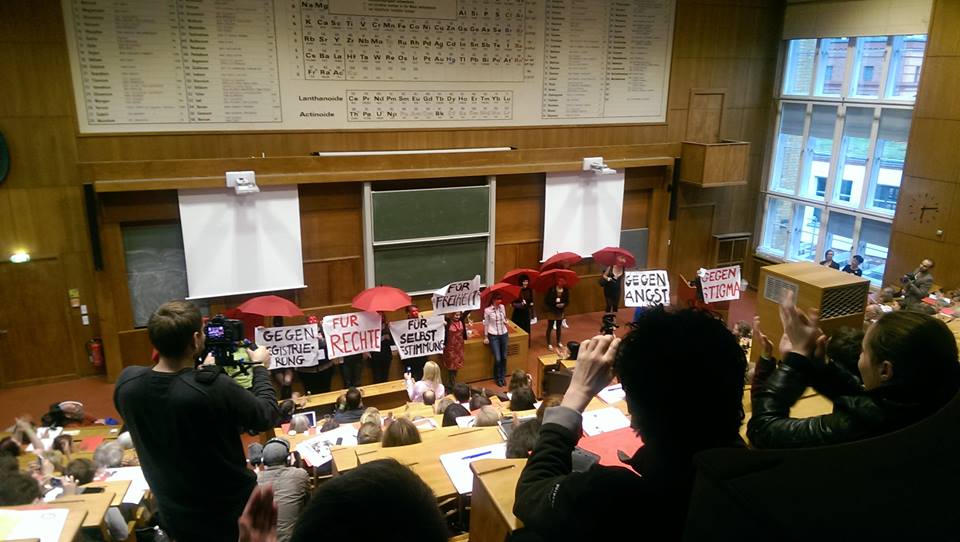
Sex Worker Congress 2014 in Berlin, Demands for equal rights and to end the stigma. © Photo credits Mira Fey
Yesterday, Amnesty International (AI) adopted a resolution which authorized their International Board to develop and adopt a policy on the advancements of human rights of sex workers through decriminalization. For the past weeks, this vote has been subject to an online controversy gone viral (for articles in main newspapers, see The New York Times, The Independent, and The Guardian). The Coalition Against Trafficking in Women (CATW) headed opponents through publishing an open letter urging AI to cast a negative vote, portraying the resolution as assistance to pimps and brothel owners. The letter was signed not only by anti-sex work campaigners, but also by various Hollywood actresses and actors – Lena Dunham, Kate Winslet, Meryl Streep, Anne Hathaway, Emma Thompson, Lisa Kudrow, Kevin Kline, Christine Baranski, and Chris Cooper, which inevitably helped its popularity online. However, the letter was heavily criticized on various news outlets and blogs for ignoring the actual content of the resolution, focusing on consensual paid sex between adults, and with that the reality of sex workers.
In order to grasp the importance of the content of the resolution, it is necessary to contrast it to the claims of its main opponents, the abolitionists. The large majority of voices discrediting AI for adopting this policy suggestion are in favor of the so-called Swedish (or Nordic) model advocating an abolition of all prostitution through eradicating the demand by punishing only the buyer, but not the seller. This policy approach was first implemented in Sweden in 1999, and since then also in other Nordic countries and Northern Ireland (as well as adopted as non-binding resolution in the European Parliament). Its underlying notion is that prostitution is a fundamental violation of women’s rights, it is seen as sexual exploitation and rape, never consensual, but always forced. If not directly, force stems from economic needs, or certain psychological conditions or experiences. Thus, in order to come closer to gender equality, prostitution needs to be abolished, the women involved – victims – need to be liberated. Through criminalizing only the buyer (as well as pimps), but not the seller, the exploited woman, these are supposed to be protected while the alleged culprit and abuser is punished.
So why is AI proposing decriminalization of both seller and buyer instead when a large number of feminists support the Swedish model? I will list five aspects here that are ignored in policy approaches such as the Swedish model and by the anti-sex work activists to show the relevance of an influential NGO such as AI taking the decriminalization approach.
1. The underlying assumption of the Swedish model ignores that not all sex workers are women. In some countries, up to 20 percent are male or transsexual. These are further marginalized through abolitionist approaches based on prostitution as exploitation of women. A more gender-neutral approach would highly benefit the protection of human rights.
2. Trafficking and forced prostitution are already illegal according to the relevant UN protocol, ratified by the General Assembly in 2000 and thereby supposed to be incorporated into national legislation globally. The terminology of the protocol is broad enough to fit a variety of aspects of force, not only the involuntary transport of a person into a different place. Countries regulating prostitution instead of criminalizing it such as Germany and the Netherlands outlaw any kind of forced prostitution strictly. Abolitionists connect trafficking and forced prostitution specifically to what is called modern slavery, mainly for advocacy reasons (see Julia O’Connell Davidson, “The making of modern slavery: whose interests are served by the new abolitionism?”, British Academy Review, Issue 24, Summer 2014, for a short, but comprehensive overview of the development of the new abolitionism and anti-trafficking advocacy networks of which also above-mentioned CATW is part).
3. However, this leads to a different topic of debate, the idea of force and coercion. Following the Swedish model, forced prostitution does not only consist of direct physical coercion and trafficking victims, but also other forces. Accordingly, also women who enter the sex industry without being pressured into it by someone else are forced by severe economic conditions since no woman would willingly do so, if not due to specific psychological conditions. This argument might seem convincing at first to everyone who cannot imagine “selling their body” – however, sex workers argue they provide sexual services instead. Here, I want to remind of cleaners or domestic care-takers. Most people would not enter these jobs if not for a lack of money, and would not describe these as the job they dreamed of as a child. Additionally, these jobs are also highly gendered; the majority of cleaners and care-takers are female. Nevertheless, there is no equivalent advocacy network trying to abolish the patriarchic system of domestic work for the true advancement of gender equality (while this is a long-term feminist academic concern). Cleaners, forced by economic constraints to wipe toilets on a daily basis, are somehow not a victim as sexy as the sex slave is.
4. This difference might be connected to the stigma attached to prostitution; the abolitionist inability to imagine anyone would choose to enter the sex industry is just one expression of this. Sadly, the Swedish model does not counteract the stigma, but reinforces it by ignoring sex workers’ voices as these are seen as privileged, but somewhat crazy women not representative of the majority of people in the sex industry. Additionally, parts of the policy actively curtail the rights of sex workers: for example, if these are working in their rented apartment and the landlord finds out, s/he is obliged to end the contract, otherwise they could be seen as procuring prostitution. Moreover, instead of “protecting” women who allegedly entered the sex industry under force, for example economic pressure, their livelihood is taken away by criminalizing their customers. Mothers in the sex industry must fear that the state will take custody of their children if their profession is revealed. As a result of these aspects, sex workers might have to accept clients without being sure that these are not indeed abusers to avoid police or other people noticing.
5. Finally, the abolitionist notion that all buyers are abusive and exploitative does not hold. Even without looking at the typical client going to brothels, one can understand this simply by remembering that paid sexual services might be the only solution for some people, for example with disabilities. In these cases, the power relations between seller and buyer are arguably different and more likely not abusive. Furthermore, as stressed above, the AI resolution only aims at consensual paid sex among adults, it explicitly condemns children below 18 in the sex industry or any form of force captured by the UN protocol. Thus, the majority of abusive buyers and pimps are excluded from the resolution. Instead, it might be more interesting at looking at the possibility of choosing to offer paid sex, brilliantly explored by Laurie Shirage in The New York Times.
Due to these five aspects, I do not agree with the Swedish model and the abolitionists, but instead welcome the resolution proposed by Amnesty International. The two years spent on this very short document indicate their concern for listening to all voices out there, sex worker organizations, prostitution survivors, and also abolitionists. It gives hope to see that such a highly regarded NGO assumes this position, hope for the actual advancement of human rights for people in the sex industry.
For some examples on how benefitial for people in the sex industry the decriminalization of prostitution is, see “The Strange Story Of How Rhode Island Accidentally Legalized Prostitution” and “New Zealand ‘the best country to work as a prostitute’, says sex worker advocacy group“.




Laisser un commentaire
Soyez le premier à laisser un commentaire